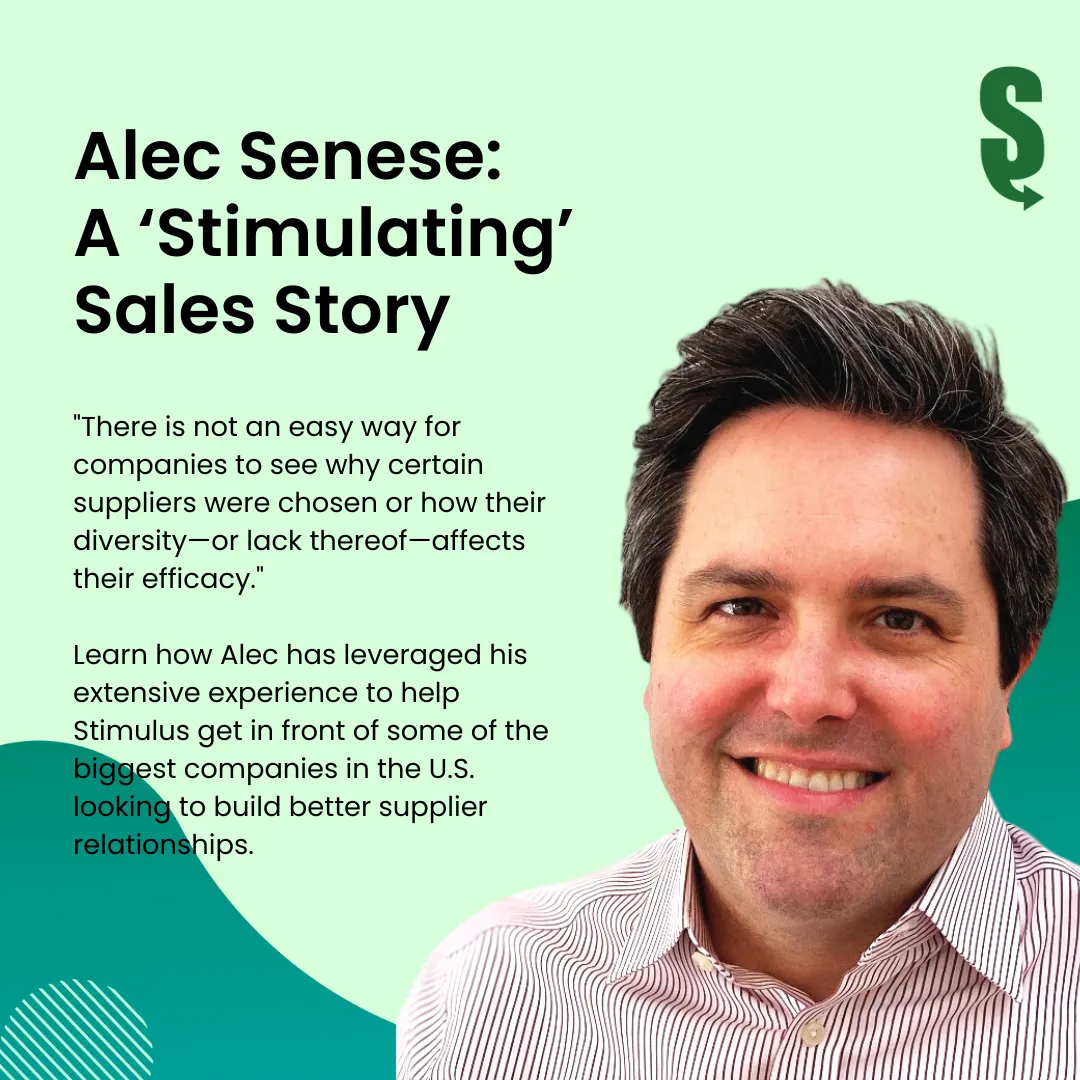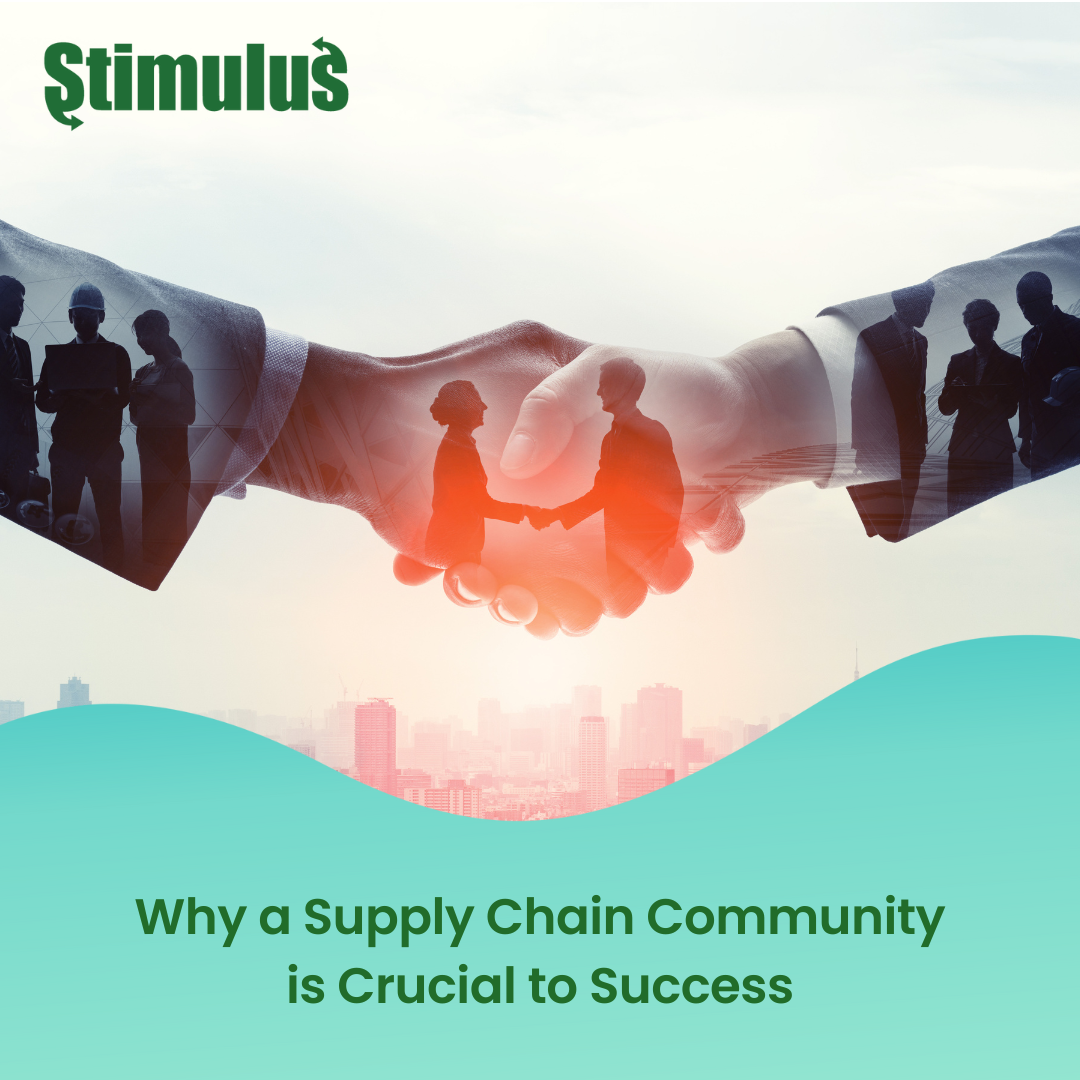Alec Senese: A ‘Stimulating’ Sales Story

Your supply chain is only as effective as the team you choose to manage it. This is why Stimulus prides itself on working with the most dedicated and experienced team of data analysts, business and sales experts, leaders, and marketing executives from all walks of life. It is with these key insights and assets that Stimulus has been able to redefine supply chain management and create lasting connections with major players in the market for a more inclusive and localized future.
As the Director of Sales and Business Development at Stimulus, Alec Senese plays a very important role in growing the sales pipeline, building relationships and closing deals. Alec is an expert in prospecting, generating leads, and establishing new business contacts to mutually benefit companies, customers, and communities. But, to truly see how Alec’s insights help the industry and Stimulus thrive, we sat down with the enigmatic leader to ask him some of the burning questions we’re sure our readers would love to dive into — starting with his experience in the industry.
Understanding the Importance of Every Level of Sales
Alec Senese has over 15 years of experience deploying solutions-led strategies to increase profitability across a variety of organizational environments. He has achieved over $10M in sales since 2012 and formed more than 450 new business relationships, including nine of the Fortune 100. He also holds a B.A. in Philosophy from Fairfield University and an M.B.A. from the Zicklin School of Management at Baruch College. But, to truly understand how his background will help skyrocket Stimulus to the top of the supply chain management market, we delved deeper into his past below.
When asked about his background experience in sales and business, Senese shared how he has been involved in sales and procurement since the start of his career, “I started after college working at a university/research institute in New York City in the housing department and was involved in the purchasing process so that would have been my first exposure to sourcing and purchasing. Over the last twelve years, I’ve been involved in sales and business development specifically, the first portion of that in retail sales (B2C) and then software and B2B sales afterwards.”
Senese also explained how his insights into every level of sales has helped him to understand the importance of supply chain management all along, “During my time in retail, I was directly involved in sourcing to help with manufacturing and getting the right materials from the right folks domestically and internationally. I was even involved in overseeing a product recall at one of my positions because of faulty testing on a product one of our suppliers was sending us. That was when I could finally see the direct consequences of disconnected supplier relationships and the importance of sourcing correctly and appropriately.”
Finally, Senese shared how a stint in food safety helped him to understand how important supplier standards are for the wellbeing of all involved, “My most recent position before my time with stimulus was involved in the public health and safety space, specifically food safety. The entire food safety industry is predicated on having visibility and insight into the supply chain, and we all should be grateful for the amazing work that people do in that industry here in the United States and around the world. It ensures that the food we all consume isn’t just accessible but safe to consume likewise.”
With experience in various levels of sales, procurement, supply chain management, and safety protocol, Senese is considered a valuable asset on the Stimulus team. But, how did his collaboration with Stimulus Inc. and Founder & CEO, Tiffanie Stanard, begin? This is the topic we chose to discuss with the sales expert next.
Working With Stimulus to Stimulate the Future
Senese’s career with Stimulus began in February 2022 and, as he puts it, was a real ‘no-brainer’ to accept, “It was not a difficult decision for me wanting to apply and hoping that I could join Stimulus. I believe strongly in Tiffanie and her vision. She is a tenacious and visionary leader with an unflappable tenacity. I envy her steady demeanor in growing a startup. I’ve worked for several startups, and that level of dedication and leadership is rare.”
However, Stanard’s leadership and determination was not the only reason Stimulus appealed to Senese, “We have an extremely professional and competent team. That also was something that I was very impressed with when I did research before joining. This, built in with the investors/partners that we have attracted including Morgan Stanley, Google, Microsoft and more, has been a huge part of our success and why Stimulus is so attractive to leaders such as myself.”
Still, Senese found that the most valuable part of the Stimulus team was truly its mission, “After doing research, I believe that the areas of supplier diversity and relationship, vendor, and supplier management have a lot of potential for growth. I believe it’s been an underserved segment and there’s just a tremendous amount of potential to grow our business in this space. We have the team and the skills to achieve a more connected and diverse supply chain industry which is a major bonus for working at Stimulus in my book.”
To see just how effective Stimulus can be when working with companies for supply chain management, we then discussed the topic of direct and indirect spending as well as how companies can get a better handle on making informed purchases across the board.
Redefining Direct and Indirect Spend Transparency for Profitability
The problem is clear, as Senese sees it, “We spend a lot of time talking to educational institutions, healthcare facilities, and professional services organizations like law firms or construction companies. What we’ve found is that there seems to be a somewhat segregated approach to direct spending (purchases of goods and services directly involved in the manufacturing of a product) compared to how indirect spend is handled, which can sometimes be up to 20–30% or more of what a company spends. Indirect spending is money that the company is spending with suppliers which does not directly relate to making money or producing. It’s more from an operational perspective and, as such, that segment of spend is less understood by business owners. There is not an easy way for companies to see why certain suppliers were chosen or how their diversity — or lack thereof — affects their efficacy.”
This disconnect has created a dilemma that Senese hardly believes to be small in stature, “While companies spend thousands on direct spend and focus most of their time on these major expenses, there are hundreds, even thousands of other purchases that account for $5,000 or less with very little transparency regarding what supplier was chosen and how they performed for future reference. But, if you add them all up, these ‘small spends’ become a massive spend that companies truly need to address moving forward for success.”
However, the sales and business leader believes Stimulus has the answer to this dilemma, “Stimulus is able to help in these situations as our technology provides a way for companies to manage all expenditures and supplier relationships through API’s and ways to sync up with other systems. Stimulus is able to assist with the larger, more complex purchases, but also has relevance with the smaller daily spend the procurement departments lose sight of. It provides visibility into what the company is spending, why, and with whom when it comes to those indirect, less expensive purchases. Over time, this can really add up to quite a substantial amount of money and this is why I believe our team truly fulfills an important supply chain management niche in that regard.”
On top of Stimulus’ ability to help with profitability for companies, Senese believes its diversity initiatives will help companies thrive in a far more equitable future.
Implementing a Supplier Diversity Program is the Now and the Future
When discussing the efficacy of supplier diversity programs in business, Senese began by defining these programs as he sees them, “A supplier diversity program is a proactive, formalized program that encourages the consideration of collaborating with suppliers who meet a prespecified set of criteria. That criteria could be women-owned, veteran-owned, minority-owned, or even locally-owned, and the reason that I think it’s important to mention being proactive and formalized is that many companies tend to create these programs with a reactive approach that simply isn’t good enough given the way the market is shifting.”
To help companies appeal to the future of industry, Senese believes a proactive approach is key, “I think one of the things that Stimulus helps companies do is become more proactive and agile in diverse supplier acquisition. Secondly, companies need to be formalized and have benchmarks and goals in order to understand how the company who is making the purchasing decisions is improving over time.”
When asked about the benefits of supplier diversity programs, Senese stated, “I think there are several benefits. One is creating a Supplier Diversity Program that necessitates a business to examine its existing supply chain. Companies tend to have no idea if their suppliers are diverse or not and so, by just starting a program, you have to have a baseline and there’s value in taking a look at the current supply chain and understanding where that baseline is.
Secondly, it encourages buyers to reevaluate their criteria and methodology. To my point earlier about being formalized, they have to really think about and understand what the goal or purpose of their particular program is and how they want that to affect not only their business, but the different communities and areas that they would like to impact through their purchasing power.
Thirdly, it opens their supply chain up to new and potentially superior businesses. People typically take the path of least resistance, and it’s much easier to buy something from someone that you’ve already bought from for many years than to take a look at three other suppliers who may be women, minority, or local-owned. However, to objectively compare and contrast the company that you’re currently purchasing from with these other businesses, and having all that data together in a comparison chart, can be very helpful to make the most informed decisions possible.”
To help companies achieve this success and see the data to compare diverse suppliers more effectively, Senese believes Stimulus reigns supreme, “That’s one of the several benefits that Stimulus allows. Stimulus is able to help an organization create or improve their Supplier Diversity Program by providing an easy-to-use and intuitive interface to ‘discover, evaluate, select, and manage’ suppliers. It can be used as either a standalone vendor management tool where companies can track the selection and evaluation process all in one place on a project or contract level and teams can interdepartmentally work on these projects together within the platform, or it can be integrated into other systems. The use of Stimulus can help companies make better decisions in less time and increase their visibility which leads to less risk and helps companies diversify and increase the value of their supply chain.
You can reduce risk through less dependency and compare effectively. Buying from 10 suppliers is more risky than buying from 30 suppliers, but by diversifying your supply chain, you’re establishing new relationships, you’re getting a better sense of what’s happening in the market, you’re getting new perspectives and new inputs from your suppliers that you may not get if you stick with the tried and true, and you’re also increasing the bottom line through greater competition by diversifying and increasing the scope of who can do business with you.
Lastly, I would say that a well-thought-out supplier diversity program helps companies to display their conscious intent to contribute to the greater good and create a more compassionate, secure, and stable macro-economy. Consumers are aware of the fact that their purchasing power is a way to ‘vote,’ so to speak, and companies that take the time to analyze the impact their suppliers have on their community and their macro-economy and consumers’ lives tend to earn those votes with ease. This consideration reflects very positively on companies and show consumers that they take these initiatives very seriously and are putting in place a proactive and measurable program that they can then share with their customers, employees, and community at large.”
With the present being carefully structured and taking a more proactive and diverse approach moving forward, the final question we chose to ask Director of Sales at Stimulus, Alec Senese, was what he thought the future of the industry might look like if the supply chain were to be successful and streamlined moving forward.
The Future is ‘Stimulating’ With Stimulus
According to Senese, the future of the industry is defined — and Stimulus is at the forefront of it all, “I recently read an article published by McKinsey that outlined components of the future of procurement and supply chain management. It really resonated with me because I believe Stimulus can have a direct impact on these components for companies moving forward.
The first thing that companies need to do is strengthen the resilience of their own supply chain. There have been a lot of issues with the supply chain over the last couple of years globally which comes as no surprise to company leaders. However, strengthening the resilience of one’s supply chain is the first thing that these leaders need to focus on and consistently examine and re-examine. There has to be continuous appraisal and reappraisal of who they’re buying from, why they’re buying from them, and how much they’re spending for the products.
Secondly, they need to strengthen their supplier relationships. This is something that Stimulus can absolutely help with. A lot of the existing software related to vendor management and supply chain management has more to do with the purchases and tracking costs solely while Stimulus is more focused on the relationships themselves and maximizing as well as extracting value from these relationships.
Thirdly, companies need to track more comprehensible and actionable data and analytics. Stimulus is entirely focused on providing this kind of information. Our data analysts are highly skilled and create breakdowns that companies can use to quite literally predict the future and strengthen relationships without fail.
Fourthly, companies need to improve their team skills. A lot of people get stuck in their ways and have been doing things like purchasing the same way for a long time. It’s important that companies invest in their employees learning new skills and being open to doing things in new and potentially better ways if they want their business to thrive in the new market.
Lastly, companies have to become more agile and be able to adapt more quickly as the world becomes more interconnected than ever before. Changes that are happening on the other side of the planet can have an immediate impact on what’s going on with your business. As such, businesses have to have tools to be able to react and adapt with agility. If companies can do these things, they can succeed with our system and have a supply chain that truly does exemplify the future and withstands any disruptions in its path.”
All in all, Alec Senese’s experience and insights provide Stimulus and its customers with a structured and proactive future free from the roadblocks and nebulous data of the past. We are pleased to have him on our team and look forward to success and growth with this business and marketing leader by our side. To learn more about the Stimulus Relationship Intelligence Platform (SRIP) that Senese believes so strongly in, check out getstimulus.io today.
.png)

.png)
.png)
